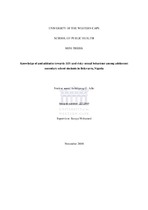| dc.description.abstract | Aim: The purpose of the study was to assess the knowledge of the transmission and prevention of HIV/AIDS among secondary school students in Bekwarra, Cross River State, Nigeria; to appraise the students' attitudes towards HIV/AIDS; to describe the risky sexual and other behaviours they engaged in and what factors influenced such behaviours. This study was conducted in the area to systematically examine the widely held notion that adolescents were deviating from the strict sexual mores of the Bekwarra people, thereby exposing themselves to the risk of acquiring HIV. Methods: Information was collected using a cross-sectional survey based on a 64 item questionnaire adapted from the Family Health International HIV/AIDS/STD Behavioural . Surveillance Surveys. A random sample of 381 male and female students aged 14 to 18 selected from 12 secondary schools participated in the survey. Results: The level of general awareness of HIV/AIDS was high - 56.9% of participants knew how HIV is transmitted - but their knowledge of STI symptoms was low. Only 24.7% knew at least two STI symptoms in women, while only 20.7% knew at least two STI symptoms in men. One hundred and twenty three (32.2%) students constituting 68 males (17.8%) and 55 females (14.4%) had experienced sexual intercourse. The mean age at first sexual experience was 15.06 years for males and 14.95 years for female students. There was a statistical association between age and experience of sexual intercourse (p = .024). Two thirds (65.0%) of the 123 sexually experienced students had intercourse in the last six months, and only 30 of them (24.4%) had used a condom during their last intercourse. The use of condom was most frequent (10.6%) at age 18 and least frequent (.8%) at age 14. About one quarter (26.1%) of the students had taken alcohol: 17.3% occasionally, 5.5% moderately, and 2.6% frequently. There was a statistical association between taking alcohol and age (p = .038). Over a half (56.1%) of those who had not had sexual intercourse also had not taken alcohol. In contrast, 14.2% had sexual intercourse and also took alcohol, indicating significant statistical association (p < .001).). 66.8% of the students had neither used drugs nor taken alcohol, whilst 6.8% had both used drugs and taken alcohol, indicating significant association, (p < .001)). There was a similar association between sexual intercourse and using drugs, (p = .002). Conclusions: The study revealed significant high risk sexual behaviour among adolescents in Bekwarra. The high level of risky sexual behaviour and lack of basic knowledge about STIs indicated that access to information is currently insufficient. Health and educational authorities in Bekwarra should utilize the key findings highlighted from this study to design more effective local strategies for sexual health promotion that may help to slow the spread of STIs including HIV/AIDS. Intensive child-friendly programmes for pre-teenagers organized by educators to promote postponement of the early initiation of sexual intercourse may be effective. For adolescents who are unable to control their sexual initiation, improved education on safe sexual practices, especially the use of condoms appears to be necessary. | en_US |

